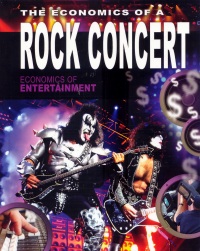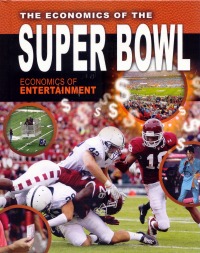| ________________
CM . . .
. Volume XXI Number 2. . . .September 12, 2014
excerpt:
Though entertainment is a multi-billion dollar industry, it is not without risk. The new “Economics of Entertainment” series, currently numbering four titles, explores the production, distribution and consumption of goods and services in a variety of genres, ranging from cinema to NFL football. Anyone who has questioned the high cost of rock concert tickets or a recently released video game will find plenty of information in this series. In fact, there is almost too much information, for, unless the reader is especially interested in the topic, he or she just might give up long before the last page. Terms such as opportunity cost, price elasticity, oligopoly, and consumer sovereignty take the series above the average middle school student’s vocabulary, and several of the charts and graphs might be difficult for the lower range of the target audience to interpret. Interspersed throughout the text are boxes, some with trivia, some with quotes, and others posing questions for the reader. Examples of the featured genre and the colour photographs are very current. For instance, readers will recognize several of their favourite singers and bands in the title about rock concerts. A table of contents, a glossary, an index and a list of related books and websites are included. In the business world, a rock concert is considered an “experience good” (a product paid for before the purchaser knows its quality) and is the only form of entertainment that has not been affected by the recent recession in the United States. The Economics of a Rock Concert takes readers from promotion to production and beyond to profit-splitting when all of the bills have been paid. What all concerts have in common is talent, venue and marketing, and all of these factors determine the cost of the ticket. Readers might be surprised to learn that their ticket helps to pay for the venue, travel, costumes, lighting, accommodations, and staff, from chefs to roadies. They will also find interesting the concert set-up, sponsorship, and the carefully calculated image, called branding, that is created by the marketing team for the artist(s). Other topics include the financial benefits of endorsements, the future of rock concerts with respect to live video streaming, and writing camp, during which the best songwriters and musicians gather for a few weeks of solid songwriting for a specific artist. Though most ideas for video games never make it to production, in 2012, the U.S. video game industry achieved $20.77 billion in sales of games, gaming systems and accessories. The Economics of a Video Game explores, among other topics, the concepts of supply and demand, intellectual property and profit sharing as they relate to the creation of video games. In this title, the roles of the various members in the core, production, Quality Assurance, and marketing teams are explained, along with the roles and financial commitment of the publisher and developer. These days, it takes about $100 million to produce a game, and console games are two years in the making, creating a buzz long before the release date. Series games are popular because companies believe that players who enjoyed the other games in the series will also enjoy subsequent games. Some examples of these are Super Mario and Angry Birds. Clever marketing also adds to the coffers of video game companies because kids will want to buy, for instance, the Super Mario t-shirt or the Angry Birds stuffed toy. Other topics in this title include digital downloads, piracy, and how “free” games make money. The Economics of Making a Movie highlights the risky, multi-billion dollar film industry which is largely based in Hollywood, dubbed “The Dream Factory”. Financing a movie is extremely expensive. Hypothetically speaking, a movie could cost $65 million to produce and $20 million to promote, yet it might last only two weeks at the box office. One example of such a film is John Carter which cost $300 million and was a huge box office failure. In making a movie, there are “above the line” costs (fixed cost items) and “below the line” costs (the direct costs of the film shoot). Budget busters add even more to the cost of film production, They could be special effects, car chases, explosions or the creation of new “worlds”. In this title, readers will learn the important roles of the director, art director, film editor, set designer, to name a few, along with the post-production tasks such as editing, composing the movie score, and marketing and distribution. Other revenue streams for a film include the sale of DVDs, merchandise and soundtracks. Disney and Universal Studios also have theme rides to promote their movies. Interestingly, merchandise sales often make more revenue than the actual film does. One example is Cars. Though it only earned $461 million at the box office, sales of merchandise totaled $10 billion. To many fans, Super Bowl Sunday is an exciting culmination to the NFL season. But to those involved in the Super Bowl’s planning and production, it is much more than that, especially from a financial point of view. In 2013, the Super Bowl had 164.1 million TV viewers. The Economics of the Super Bowl touches briefly on the history of the NFL and the Super Bowl, followed by information about the effects that the Super Bowl has on businesses, most especially in the host city. These include a boost in hotel, restaurant, gas station and airline revenue. In fact, it is estimated that the cost for two adults to attend the Super Bowl in another city for a weekend would be $10,000. But even cities that do not host the game can benefit: many local restaurants offer Super Bowl meal specials to entice customers. This title also offers information about the criteria for a city’s being chosen to host the Super Bowl, how tickets are allotted, personal seat licenses, the cost of luxury suites, hidden costs (ushers, security, maintenance, food vendors and ticket takers), sponsorship and stadium-naming privileges. As well, the much-touted half-time show usually features a well-known artist or band, but often these singers perform for free because the phenomenal exposure on national television will result in greater album sales. Exposure of a product via TV ad, however, costs an exorbitant amount of money. In 2012, a 30-second spot cost $4 million, and there are approximately 55 commercials per game. As mentioned previously, several of the terms in these titles can be rather difficult for readers to grasp. In this particular book, aggregate supply, aggregate demand, microeconomics and macroeconomics are just a few of the terms used. Very thorough, with plenty of information augmented by diagrams, graphs and charts, this series is meant for the reader who is passionate about the subject, but it is not for everyone. Recommended. Gail Hamilton is a former teacher-librarian in Winnipeg, MB.
To comment
on this title or this review, send mail to cm@umanitoba.ca.
Copyright © the Manitoba Library Association. Reproduction for personal
use is permitted only if this copyright notice is maintained. Any
other reproduction is prohibited without permission.
Next Review |
Table of Contents for This Issue
- September 12, 2014. |



